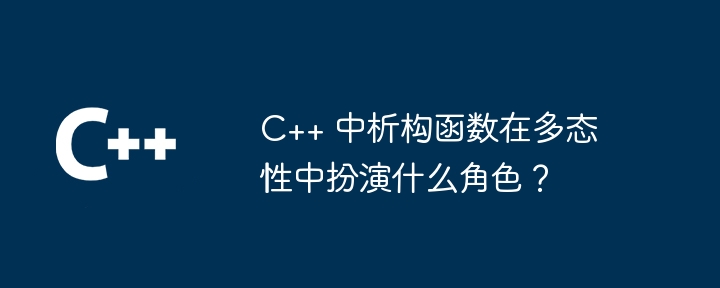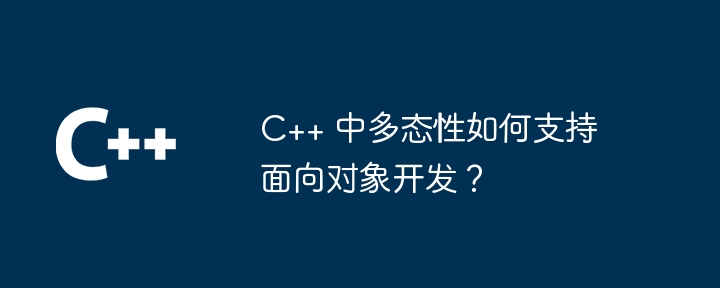
The difference between Java interfaces and classes: polymorphism and flexibility
Java is an object-oriented programming language, and interfaces and classes are one of its important concepts one. Interfaces and classes have different uses and characteristics in Java. This article will introduce the differences between interfaces and classes from the aspects of polymorphism and flexibility, and provide specific example code to illustrate.
1. Polymorphism:
Polymorphism is one of the core concepts of object-oriented programming, which refers to the fact that objects of the same type have different behavioral characteristics. In Java, both interfaces and classes can achieve polymorphism, but the way they are implemented is different.
- Polymorphism of classes:
Polymorphism of classes is achieved through inheritance and overwriting. After a subclass inherits a parent class, it can override the parent class's methods to change the behavior of the methods. When the program is executed, polymorphism can be achieved by pointing to the subclass object through the reference of the parent class.
The sample code is as follows:
class Animal{
void sound(){
System.out.println("动物发出声音");
}
}
class Dog extends Animal{
void sound(){
System.out.println("狗发出汪汪声");
}
}
class Cat extends Animal{
void sound(){
System.out.println("猫发出喵喵声");
}
}
public class PolymorphismTest {
public static void main(String[] args) {
Animal animal = new Animal();
Animal dog = new Dog();
Animal cat = new Cat();
animal.sound();
dog.sound();
cat.sound();
}
}Output result:
动物发出声音 狗发出汪汪声 猫发出喵喵声
In the above code, the Animal class is the parent class, and the Dog and Cat classes are children of the Animal class kind. In the main method, Animal, Dog and Cat objects are created respectively, and the sound() method of the corresponding subclass is called through the reference of the parent class. Due to the existence of overriding, the actual results obtained when calling the sound() method of different objects are also different. This reflects the polymorphism of the class.
- Polymorphism of interfaces:
Polymorphism of interfaces is achieved by implementing interfaces and references to interfaces. A class that implements an interface must implement all methods defined in the interface to achieve polymorphism.
The sample code is as follows:
interface Animal{
void sound();
}
class Dog implements Animal{
public void sound(){
System.out.println("狗发出汪汪声");
}
}
class Cat implements Animal{
public void sound(){
System.out.println("猫发出喵喵声");
}
}
public class PolymorphismTest {
public static void main(String[] args) {
Animal dog = new Dog();
Animal cat = new Cat();
dog.sound();
cat.sound();
}
}Output result:
狗发出汪汪声 猫发出喵喵声
In the above code, Animal is the interface, and Dog and Cat are classes that implement the Animal interface. In the main method, the references through the Animal interface point to the Dog and Cat objects respectively, and the sound() method is called. Similarly, because the methods in the interface are implemented differently in different classes, you will get different results when you call the method. This reflects the polymorphism of the interface.
2. Flexibility:
Flexibility refers to whether modifications and extensions to implementation details can be easily implemented in program design. The difference in flexibility between interfaces and classes is mainly reflected in the following two aspects.
- Flexibility of classes:
The flexibility of classes is mainly reflected through inheritance and polymorphism. When you need to modify a class, you only need to modify the subclass, which will not affect other codes that use the class. This flexibility achieved through inheritance makes the code more extensible. - Flexibility of the interface:
The flexibility of the interface is mainly reflected in the expansion and modification at the interface level. When requirements change, only the interface needs to be modified, without modifying the class that implements the interface. This flexibility achieved through interfaces makes programs easier to maintain and expand.
To sum up, although both interfaces and classes can achieve polymorphism, they are different in their uses and characteristics. Classes achieve polymorphism mainly through inheritance and overriding, and interfaces achieve polymorphism by implementing interfaces and references to interfaces. In terms of flexibility, classes are mainly realized through inheritance and polymorphism, while interfaces are mainly realized through extension and modification at the interface level. Therefore, in actual applications, the use of interfaces and classes needs to be weighed as needed to achieve better software design results.
The above is the detailed content of Differences between Java interfaces and classes: Polymorphism and flexibility. For more information, please follow other related articles on the PHP Chinese website!
 C++ 中继承和多态性如何影响类的耦合度?Jun 05, 2024 pm 02:33 PM
C++ 中继承和多态性如何影响类的耦合度?Jun 05, 2024 pm 02:33 PM继承和多态性会影响类的耦合度:继承会增加耦合度,因为派生类依赖于基类。多态性可以降低耦合度,因为对象可以通过虚函数和基类指针以一致的方式响应消息。最佳实践包括谨慎使用继承、定义公共接口、避免向基类添加数据成员,以及通过依赖注入解耦类。实战案例展示了如何使用多态性和依赖注入降低银行账户应用程序中的耦合度。
 C++ 中析构函数在多态性中扮演什么角色?Jun 03, 2024 pm 08:30 PM
C++ 中析构函数在多态性中扮演什么角色?Jun 03, 2024 pm 08:30 PM析构函数在C++多态性中至关重要,它确保派生类对象在销毁时正确清理内存。多态性允许不同类型的对象响应相同方法调用。析构函数在对象销毁时自动调用,释放其内存。派生类析构函数调用基类析构函数,确保释放基类内存。
 C++ 函数重载如何实现多态性?Apr 13, 2024 pm 12:21 PM
C++ 函数重载如何实现多态性?Apr 13, 2024 pm 12:21 PM函数重载可用于实现多态性,即通过基类指针调用派生类方法,编译器根据实际参数类型选择重载版本。示例中,Animal类定义虚拟makeSound()函数,Dog和Cat类重写该函数,通过Animal*指针调用makeSound()时,编译器会基于指向的对象类型调用相应的重写版本,从而实现多态性。
 C++ 中多态性的优点和缺点是什么?Jun 04, 2024 pm 08:08 PM
C++ 中多态性的优点和缺点是什么?Jun 04, 2024 pm 08:08 PMC++多态性的优点和缺点:优点:代码重用性:通用代码可处理不同对象类型。可扩展性:轻松添加新类,无需修改现有代码。灵活性和可维护性:行为与类型分离,提升代码灵活性。缺点:运行时开销:虚函数分派导致开销增加。代码复杂性:多继承层次结构增加复杂性。二进制大小:虚函数使用增加二进制文件大小。实战案例:动物类层次结构中,多态性使不同的动物对象都能通过Animal指针发出声音。
 Java 接口与抽象类:通往编程天堂之路Mar 04, 2024 am 09:13 AM
Java 接口与抽象类:通往编程天堂之路Mar 04, 2024 am 09:13 AM接口:无实现的契约接口在Java中定义了一组方法签名,但不提供任何具体实现。它充当一种契约,强制实现该接口的类实现其指定的方法。接口中的方法是抽象方法,没有方法体。代码示例:publicinterfaceAnimal{voideat();voidsleep();}抽象类:部分实现的蓝图抽象类是一种父类,它提供了一个部分实现,可以被它的子类继承。与接口不同,抽象类可以包含具体的实现和抽象方法。抽象方法是用abstract关键字声明的,并且必须被子类覆盖。代码示例:publicabstractcla
 C++ 函数返回值类型在多态性中的作用Apr 13, 2024 pm 09:12 PM
C++ 函数返回值类型在多态性中的作用Apr 13, 2024 pm 09:12 PM多态中,函数返回值类型规定了当派生类重写基类方法时,返回的具体对象类型。派生类方法的返回值类型可以与基类相同或更具体,允许返回更派生的类型,从而提高灵活性。
 函数重写与继承的多态性:实现对象间灵活调用的艺术May 02, 2024 am 10:30 AM
函数重写与继承的多态性:实现对象间灵活调用的艺术May 02, 2024 am 10:30 AM函数重写和继承的多态性是OOP中实现对象灵活调用的两个关键概念:函数重写:派生类重新定义基类中的同名函数,调用时执行派生类中的具体实现。继承的多态性:派生类可以以与基类相同的方式使用,通过基类引用调用方法时,执行派生类中特定于它的实现。
 C++ 中多态性如何支持面向对象开发?Jun 03, 2024 pm 10:37 PM
C++ 中多态性如何支持面向对象开发?Jun 03, 2024 pm 10:37 PM多态性是面向对象编程中允许对象以多种形式的存在的概念,使代码更灵活、可扩展和可维护。C++中的多态性利用虚函数和继承,以及纯虚函数和抽象类来实现动态绑定,使我们可以创建根据对象的实际类型更改行为的类层次结构。在实践中,多态性允许我们创建指向不同派生类对象的基类指针,并根据对象的实际类型调用适当的函数。


Hot AI Tools

Undresser.AI Undress
AI-powered app for creating realistic nude photos

AI Clothes Remover
Online AI tool for removing clothes from photos.

Undress AI Tool
Undress images for free

Clothoff.io
AI clothes remover

AI Hentai Generator
Generate AI Hentai for free.

Hot Article

Hot Tools

Atom editor mac version download
The most popular open source editor

Dreamweaver CS6
Visual web development tools

Dreamweaver Mac version
Visual web development tools

Notepad++7.3.1
Easy-to-use and free code editor

MinGW - Minimalist GNU for Windows
This project is in the process of being migrated to osdn.net/projects/mingw, you can continue to follow us there. MinGW: A native Windows port of the GNU Compiler Collection (GCC), freely distributable import libraries and header files for building native Windows applications; includes extensions to the MSVC runtime to support C99 functionality. All MinGW software can run on 64-bit Windows platforms.





